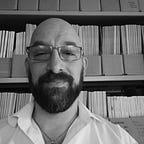The weavers of memories (02)
II. Archives and natural sciences. The frame and the weft (A)
[This post is the second of a series in which I will share a text entitled Los tejedores de memorias (“The weavers of memories”), which I produced as the final work for my master’s degree in Historical Archives and Memory at the Pontificia Universidad Javeriana in Bogota (Colombia). All posts can be viewed on my website, while the original text, complete with quotes and notes, can be downloaded here].
Knowledge management institutions (libraries, archives, museums, and other associated and similar spaces) are concerned with weaving together the many strands that make up that complex fabric called “memory”.
For these institutions in general, and for archives in particular, the work of “weaving” involves, among other tasks, the recovery, identification, organization, analysis, curation, access and dissemination of the materials they handle. This is equivalent to the search and selection of the threads needed to assemble a solid and creative warp, the laborious (re)construction of the sought-after weft, the production of the fabric, and its exhibition and use. The threads are not only entangled and intertwined with each other, giving rise to dense structures, but also make it possible to establish connections of different types with other weavings, in turn formed by their own interconnected elements.
Each of the threads is a document: an archaeological artifact, a three-dimensional object, a paper manuscript, a digital file, or some other of the many possible formats through which information has been recorded and transmitted throughout human history.
Being part of a larger structure, each thread maintains relationships of various kinds with many others, as they are all intimately intertwined with each other. This perspective emphasizes the fact that a document is never isolated: it is always produced, together with many others, in a particular context (in which it then inhabits), within the framework of a particular process, with a particular intention, and with an audience to whom it is addressed.
The sociocultural phenomenon known as “memory” results from the sum, the combination and the interaction of these strands: of each and every one of these fragments in all their formats, channels and supports, however insignificant or irrelevant they may seem.
The archive is one of the spaces in which, historically, such fragments have been preserved. One of the places where memory is woven.
***
There are a number of popular stereotypes and prejudices about the function of an archive. Its very definition, “a place where an ordered set of documents that a person, a society, an institution, etc., produce in the exercise of their functions or activities are kept” (according to the standard Spanish dictionary) shows a particular emphasis on the fact of custodianship, that is, “to keep something with care and vigilance”.
However, archival work is not limited to acting as the custodian of a collection; nor even to preservation — usually understood as the mere prolongation of the survival of certain documents. The work includes — or should include — the identification, recovery, and maintenance, from an informed and critical position, of the relationships between fragments of memory: of those that exist or may exist with other forms of information, and of those that exist between all this knowledge and the different human groups that produce and consume it.
These relationships, these intimate epistemic links, always fluid and constantly evolving, are what allow us to detect and understand the nature and potential of an individual document from various perspectives: as many as the number of threads connected to it. At the same time, they allow us to understand processes, phenomena, or events from the analysis of a wide, rich, diverse, and complex documentary mesh.
Seeing memory as a fabric implies understanding that each and every one of its constituent elements has an equivalent value and importance. From this perspective, many apparently insignificant materials, which under other circumstances might otherwise go unnoticed or even be discarded, acquire a prominence of their own. Accepting this diversity, which is naturally intrinsic to any collection, allows us to understand memory as the integral, magnificent, and kaleidoscopic whole that it is.
On the other hand, this vision of the fabric allows us to see memory as a structure that needs to maintain its integrity in order to exist. Undoing it, damaging it or fragmenting it — something sadly common in certain disciplines — implies a significant loss of connections and contents. On the contrary, preserving it allows, among other things, to carry out more integral analyses, including different positions and points of view.
Such views should include the “alternatives”, so labeled as the most marginal and “rebellious”. Such visions are extremely necessary in the area of knowledge and memory management in general, and in archival science in particular. For, as Schwartz and Cook point out, archives are not objective and neutral institutions: on the contrary, they are active participants in (and even shapers of) power relations, both political and cultural.
The archive is presented as a possible loom of memories: a space for the (pro)active and creative management of documents that are essential both for the construction of histories — the “official” one and many other possible narratives — and for other vital processes within the framework of human socio-cultural dynamics.
In spite of this, memory and archive are not always taken into account as the necessary material and powerful place for the creation and elaboration of narratives, discourses and ideas that they really are. The natural sciences are an example of a discipline for which neither of the above two elements seems to be of notable importance.
[To be continued…]
